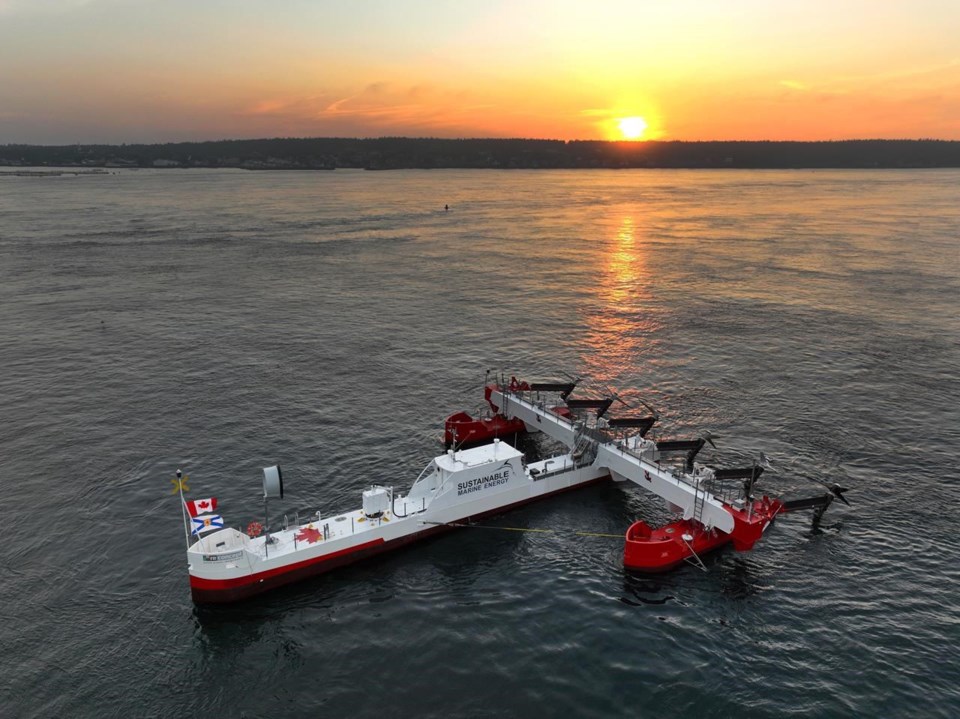HALIFAX — A firm that hoped to generate electricity from the Bay of Fundy's massive tides is instead winding up operations after a regulatory struggle with the federal Fisheries Department.
Jason Hayman, chief executive of U.K.-based Sustainable Marine Energy, says investors are placing their Canadian subsidiary into bankruptcy after fruitless talks with the department. His firm will wind up all its operations in Canada, resulting in losses of approximately $30 million to $40 million, depending on sales of equipment and assets, he added.
"We're out .... The Canadian company will be placed in voluntary bankruptcy," Hayman said in an interview Friday. "It's very disappointing for our team and everyone else."¬Ý
The company's catamaran-style tidal platforms ‚Äî with turbines resembling inverted windmills ‚Äî were praised as promising innovations when the firm installed them during a first phase of testing near Nova Scotia's Brier Island. The next step ‚Äî now cancelled ‚Äî would have been to bring them to the testing site about 200 kilometres northeast in the Minas Basin, where the world's highest tides flow.¬Ý
Sustainable Marine Energy planned to produce megawatts of electricity to power Nova Scotia homes; instead, the executive says the firm's bankruptcy will discourage other investors. "It's going to kill the whole tidal power adventure in Nova Scotia and sterilize the massive investment that's been made by the provincial government, the federal government and private investors," Hayman said.
A letter sent Thursday by the federal Fisheries Department didn't satisfy investor concerns, he said, because they couldn't see a clear way forward for the project. The regulatory hurdles imposed by Ottawa — requiring the company to monitor whether fish would collide with the tidal platforms — proved too difficult to implement, he added.
The firm had been one of four expected to operate turbines at the test facility operated by the non-profit Fundy Ocean Research Centre for Energy, near Parrsboro, N.S. The facility provides berths where tidal companies demonstrate the effectiveness and environmental impact of their technologies.
In the letter, the Fisheries Department said the project's rotors were capable of moving at 15 metres per second and could potentially impact fish. "We still don't know how well migratory fish can control their movements and avoid structures," the department said.
The letter acknowledges that sonar systems to detect fish wouldn't work in the upper levels of the water where Sustainable Marine's turbines operate. In addition, the cloudy waters of the basin make it difficult for underwater cameras to distinguish objects passing through the turbines.
Amid these "significant challenges," the department suggested Sustainable Marine Energy work with researchers on finding a technology that would succeed, repeating an offer made in March to allow the company to install a single turbine in the Minas Basin for one year and monitor whether fish were colliding with the equipment.
It said any further authorizations to test more turbines would depend on the effectiveness of whatever technology the company would develop over the next year to detect fish movements.
But Hayman says the federal government was unclear about how much information it would have needed to satisfy its concerns about potential harm to fish.
In 2020, Sustainable Marine received $28.5 million from Natural Resources Canada in what the Liberal government billed in a news release as a “historic investment in tidal energy.” The release said the project could reduce greenhouse gas emission by up to 17,000 tonnes annually and demonstrate “the ability to harness tides as a reliable source of renewable electricity.”
Graham Daborn, a biologist and professor emeritus at Acadia University, said the bankruptcy illustrates the huge scientific challenges in harnessing the world's most powerful tides.
Daborn — who has studied the Bay of Fundy's marine life and ecosystems for more than 50 years — said the scientific problems have their genesis in the selection of the turbulent waters of the Minas Basin as a test site.
"The Minas Basin in particular is very, very difficult," he said. "The velocity is higher and the turbulence is extreme. All of the devices that have been used elsewhere to look at fish movements in relation to a turbine have been in more moderate conditions."
He said that in the Minas Basin the sonar waves from fish monitors are dispersed by the air bubbles of fast-moving waters, rendering them ineffective as fish trackers. In retrospect, Daborn said, it might have been wiser to select parts of the Bay of Fundy where monitoring technologies already tested elsewhere would have worked.¬Ý
"But in this case, the fundamental question that's not answered is: can fish detect if they're approaching a working turbine, and if they can, can they avoid getting there?"
This report by The Canadian Press was first published May 12, 2023.
Michael Tutton, The Canadian Press




